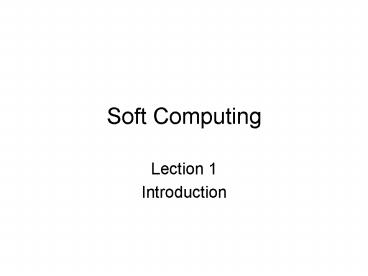Soft Computing - PowerPoint PPT Presentation
Title:
Soft Computing
Description:
'Soft computing is a collection of methodologies that aim to exploit the ... homosexuality. sky. Different representations of concepts in different languages. Blue ... – PowerPoint PPT presentation
Number of Views:126
Avg rating:3.0/5.0
Title: Soft Computing
1
Soft Computing
- Lection 1
- Introduction
2
What is SC?
Soft computing is a collection of methodologies
that aim to exploit the tolerance for imprecision
and uncertainty to achieve tractability,
robustness, and low solution cost. Its principal
constituents are fuzzy logic, neurocomputing, and
probabilistic reasoning. Soft computing is likely
to play an increasingly important role in many
application areas, including software
engineering. The role model for soft computing is
the human mind.
Zadeh, 1994
3
What is SC?
Soft computing is not precisely defined. It
consists of distinct concepts and techniques
which aim to overcome the difficulties
encountered in real world problems. These
problems result from the fact that our world
seems to be imprecise, uncertain and difficult to
categorize. Possibly our world is uncertain
really (see Quantum Theory, theory of
relativity). But question what is in reality and
what is appeared in mind is senseless
(R.A.Wilson, Quantum Psychology)
4
What is SC?
Another possible definition of soft computing is
to consider it as an anti-thesis to the concept
of computer we now have, which can be described
with all the adjectives such as hard, crisp,
rigid, inflexible and stupid. Along this
track, one may see soft computing as an attempt
to mimic natural creatures plants, animals,
human beings, which are soft, flexible, adaptive
and clever. In this sense soft computing is the
name of a family of problem-solving methods that
have analogy with biological reasoning and
problem solving (sometimes referred to as
cognitive computing). The basic methods
included in cognitive computing are fuzzy logic
(FL), neural networks (NN) and genetic algorithms
(GA) - the methods which do not derive from
classical theories.
5
Reasons of necessary of uncertainty in AI
- Objective (features of whole environment)
- Uncertainty of our world and limited capabilities
of our senses - Subjective (features of interaction with concrete
environment) - Different experience of different persons and
peoples, in particular, it maps on features of
semantics of different languages
6
Single absolute truth is exist
Absolute truths are not exist
7
Different representations of concepts by
different persons
Eyes of loving girl
sea
sky
Blue
Blue
blue spruce (kind of tree)
sky
homosexuality
8
Different representations of concepts in
different languages
- Blue
- Pale blue one word in Russian
- Dark blue one another word in Russian
- Pigmy has many single words for description of
forest - Forest under rain
- Forest after rain
- Forest in hot season
- Forest in morning
- Forest in evening
- and so on
9
The tools for soft computing
- Fuzzy logic models
- Neural networks
- Genetic algorithms
- Probabilistic reasoning
10
What is Fuzzy Logic Models?
- Its are based on Fuzzy Set Theory by L.Zadeh
- In classical set theory any Jones may member of
this set or not, but not at once - In Fuzzy Set Theory Jones at
- once may be member of this
- set and no with any
- confidence
Set of good man
11
Examples of tasks solving by Fuzzy models
- Control of clothes washer
- Making of decision in diagnostic systems (expert
systems in medicine, for example) - Making of decision in business planning
- May be used knowledge such as
- If temperature is high then diagnose is grippe
with confidence 80 - If speed is slow then increase transfer of fuel
12
What is Neural Networks (NN)?
- NN consists of many number of simple elements
(neurons) connected between them in system - Whole system is able to solve of complex tasks
and to learn for it like a natural brain - For user NN is black box with Input vector
(source data) and Output vector (result) - Examples of tasks
- Recognition of images (visual, speech and so on)
- Prediction of situations (cost of actions,
currency) - Classification and clusterization of images (for
example, in diagnostic systems)
13
What is Neural Networks (NN)?
14
What is Genetic Algorithms or Evaluation
Programming?
- Solving is described as vector of features
- Function of estimation of solving (of vector)
- Process of birth and selection of vectors of
features - Result is suboptimal solving of problem
- Examples of application
- Finding of optimal (suitable) path,
- Finding of better structure of neural network
- Finding of configuration of robot
- Optimal cutting
15
What is probabilistic reasoning?
- Uncertainty is described by probabilities
- Relations between events are described as
conditional probabilities (Bayesian nets) or
probabilities of transition probabilities
(Markovian process) - For example, action of system may be described as
graph of states -
S1 P1 S2 P2
PN SN
16
Examples of applications of probabilistic
reasoning
- Recognition of speech
- Navigation of mobile robots
- And so on
17
Difference between fuzziness and probability
(from modeling of world)
- Probability deal with unknown entity (time,
property before any event). After any event the
entity become known. - Fuzziness is own property of any entity or
(concept or object or property). It may be more
or less but not disappears practically. - May be fuzzy probability and probability of
fuzziness - Probability may be use for simulation of fuzziness

